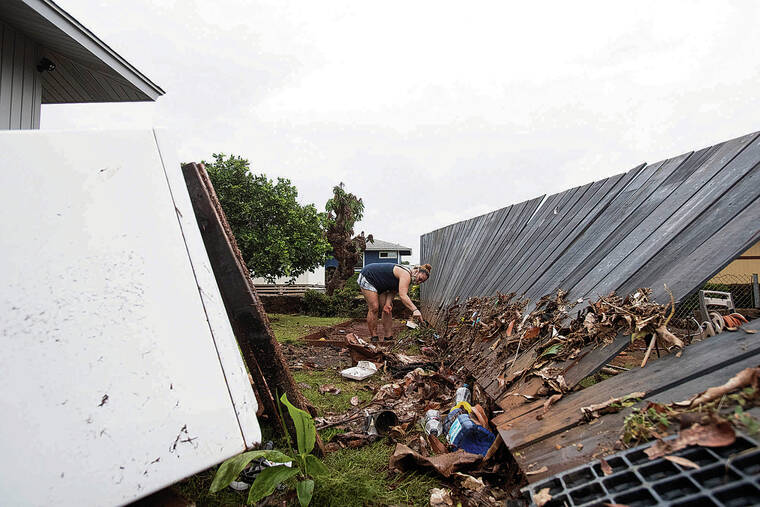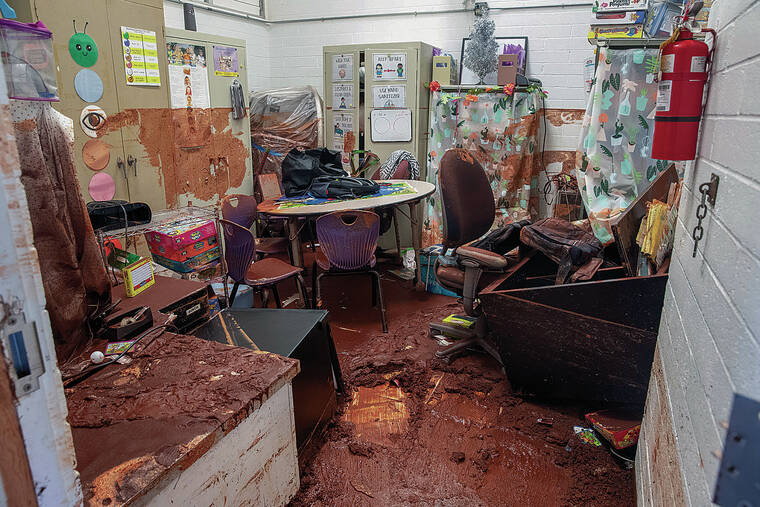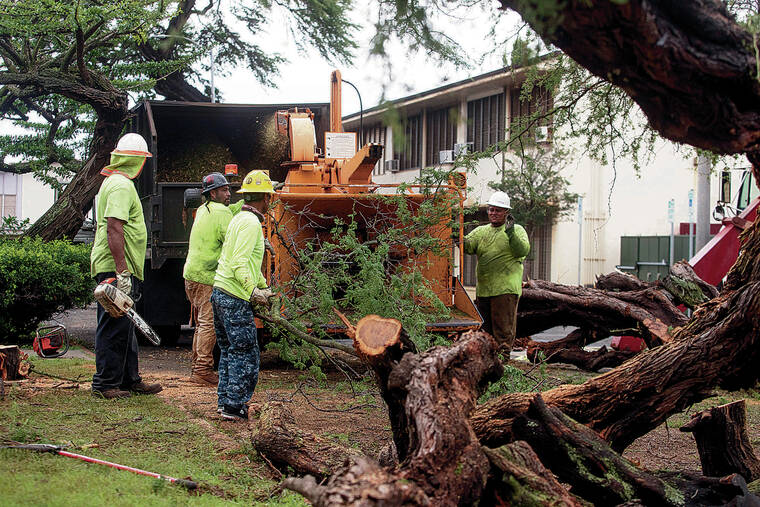While Kauai was still under a flash flood watch overnight, Oahu began drying out Tuesday from an extreme winter storm that included record-setting rainfall and winds that struck neighborhoods across the island Monday, following Maui and Hawaii counties.
People tried to salvage precious memories from their flooded homes and an elementary school’s kindergartners got Tuesday off after their escape Monday when rushing floodwaters burst through their classrooms.
Honolulu Fire Department crews responded to 90 flood-related incidents in 24 hours from 6 a.m. Monday, including 55 flooded homes, three swift-water rescues and two vehicle extrications due to high water.
HFD also responded to seven fallen trees, seven electrical shorts, six fallen power lines, four blown roofs, four arcing wires and two landslides, including one that went into a home.
The city said a section of road near 4120 Round Top Drive will remain closed for an extended period after a huge portion of the roadway pavement was taken out.
The calls came from neighborhoods from all across Oahu including Aiea, Aina Haina, Aliamanu, Hawaii Kai, Maili, Makaha, Makakilo, Makiki, Manoa, Mokuleia, Nanakuli, Nuuanu, Kaaawa, Kailua, Kaimuki, Kalaeloa, Kalihi, Kaneohe, Kapahulu, Kapolei, Pearl City, Sunset Beach, Wahiawa, Waialua, Waianae, Waikiki and Waipahu.
The Red Cross closed all its emergency shelters except for one in Makaha and another at Keaau on Hawaii island.
The storm pulled the plug on much of downtown Honolulu Monday, but Hawaiian Electric Co. officials were optimistic Tuesday that its crews could restore power to most customers by this morning. And it expected 70% of its downtown customers would have power restored by Tuesday night.
All but two public schools were scheduled to reopen today.
Farrington High School will remain closed to students after a large kiawe tree fell across its main drive Monday night, but faculty and staff were to return today.
Kula Elementary School on Maui remains closed today. Repairs to water lines in Upcountry Maui forced the school to close Tuesday.
Red Hill Elementary had power fully restored and will reopen.
Twelve classrooms were affected by flooding at Pearl City Highlands Elementary on Monday afternoon, but the school will reopen today for in-person learning except for eight classrooms.
They require more work and students who normally use them will switch to distance learning this week, including four kindergarten, two first-grade and two special education classes, the Department of Education said.
Four classrooms were filled with kindergartners when floodwaters gushed through at about 1:30 p.m. Monday. Others already had been dismissed, the principal said.
Principal Zachary Sheets said: “Within five to 10 minutes, our E Building began to get flooded. One class had to wade through
ankle-high water.”
The other classes managed to get out.
“There was so much rain at the time,” he said. “It didn’t seem to be draining. Even the drain above where it happened, water was bubbling up from it.”
“I’d like to thank everyone for their quick actions,” he said. Everyone, including those in administration, custodians and teachers, came to assist.
He said it will likely take weeks, possibly months, to clean and replace everything that is porous, including classroom libraries, student materials, shelving and cabinets.
Pearl City resident Chandra Sugitaya said her grandniece said the students in her kindergarten class stood on their desks and the teacher carried the students out of the classroom to safety.
Sugitaya, who lives just below the school, experienced the flooding as well.
“Water came gushing twice into the house,” said Sugitaya. “It was rushing through my house. In a matter of a minute, I saw the water go into every bedroom and bathroom.”
“Occasionally it’ll rain like that, but not for like eight hours,” she added.
Six city garbage bins and a 55-gallon drum from neighbors’ yards ended up in hers, and water ripped a bolted-down aluminum storage shed off its base.
A restoration expert told her anything porous likely will have to be thrown out, and that his company would cut off 3 feet of drywall to determine how bad the framing is.
Despite losing nearly everything, Sugitaya said insurance will likely not cover anything since she and her husband did not think to purchase flood insurance since the house is not in a flood zone.
She and her husband may have to rebuild their home, which was his grandmother’s house, because of the damage caused by the floodwaters rushing across the street from a neighbor’s yard, which flowed from the school.
Sugitaya blames clogged drains in the older neighborhood, which she describes as thick iron grilles. Once city crews cleared them, the water drained, but Sugitaya said the drains would repeatedly clog round after round of four heavy downpours.
The water flowed through Sugitaya’s yard onto Moanalua Road and into the homes makai of that major thoroughfare.
The Noelani Street resident says the water was 6 inches deep in her house, which is built 2 feet above ground.
Neighbors evacuated Monday night, and she finally agreed to evacuate the home early Tuesday morning.
She’s declined help to clean up until she has had time to sift through her personal belongings, including photo albums from her childhood and her children’s graduation portraits.
“I don’t want to break down and cry when they’re with me,” she said as she began to weep.
Hawaii Emergency Management Agency urged residents to document damage with video and photos for insurance purposes and in the event funding becomes available to assist with recovery.
The agency says it’s not necessary to wait for a flood insurance adjuster or inspector to come before cleaning up, but cautions people to be aware of hidden structural damage, avoid wading through floodwater, which may be hiding debris, contaminated with sewage or electrically charged.
Hawaiian Electric Co. crews had repaired two of three failed transformers by Tuesday afternoon to restore power to downtown Honolulu, which experienced a widespread outage Monday night to businesses and homes. This was due to flooding in the Iwilei substation, which damaged the transformers.
By Tuesday morning, one had been repaired, which allowed Hawaiian Electric to bring power back to the state Capitol, the State Office building, the city municipal building, Central Pacific Bank and First Hawaiian Bank, and others, said Hawaiian Electric spokeswoman Shannon Tangonan.
Another dozen buildings were expected to have power restored Tuesday night.
“One of the stumbling blocks we had during the repair was they discovered we had 300 feet of high-voltage cable that was damaged,” requiring repairing and splicing at both ends, she said.
“Under normal circumstances that takes three hours for one splice, but because we had so many folks working on this, we were able to do it simultaneously,” she said.
She explained another difficulty was trying to pump out the floodwaters, which “kept coming and coming.”
A supervisor reported the entire area was filled with water, and a manhole cover was floating.
Tangonan said the Iwilei substation was built 100 years ago, and although work has been done to create protective barriers, “the electric grid is not storm-proof.”
“We do our best to build a resilient grid, but the landscape and infrastructure has changed,” she said. “When you have something 100 years old, you do your best to protect it.”
She said that the company is aware of critical customers such as hospitals and nursing homes, which should have backup generators.
“We always want to make sure we try to restore these critical facilities first,” Tangonan said. “That’s sort of how we prioritize restoration. We’re their lifeline.”
National Weather Service lead forecaster Joe Clark said the islands will return to a regular tradewind pattern for the next seven days. He said whenever a big low pressure system develops just west of the islands with winds from the south, “it puts us at risk of heavy rain.”
“Being in a La Nina year can stack the odds, but it can happen in any year,” he said.
Unlike the middle of the continental U.S. where it takes a long time to fill up a river basin and a long time to drain out, Hawaii’s terrain lends itself to a quick onset of flash flooding.
The kona low brought a record-setting 7.92 inches of rain in Honolulu on Monday, breaking the previous record for that day of 4.11 inches in 1988. It was also the wettest December day on record, surpassing the previous single-day record of 7.89 inches on Dec. 12, 1987.
———
Star-Advertiser reporter Nina Wu contributed to this report.










